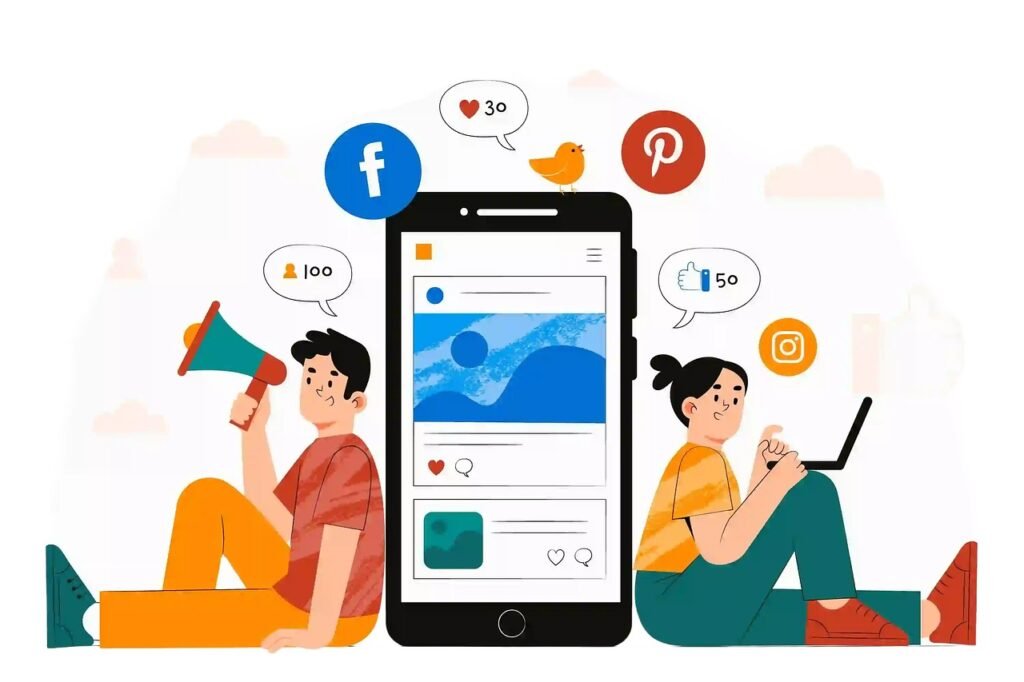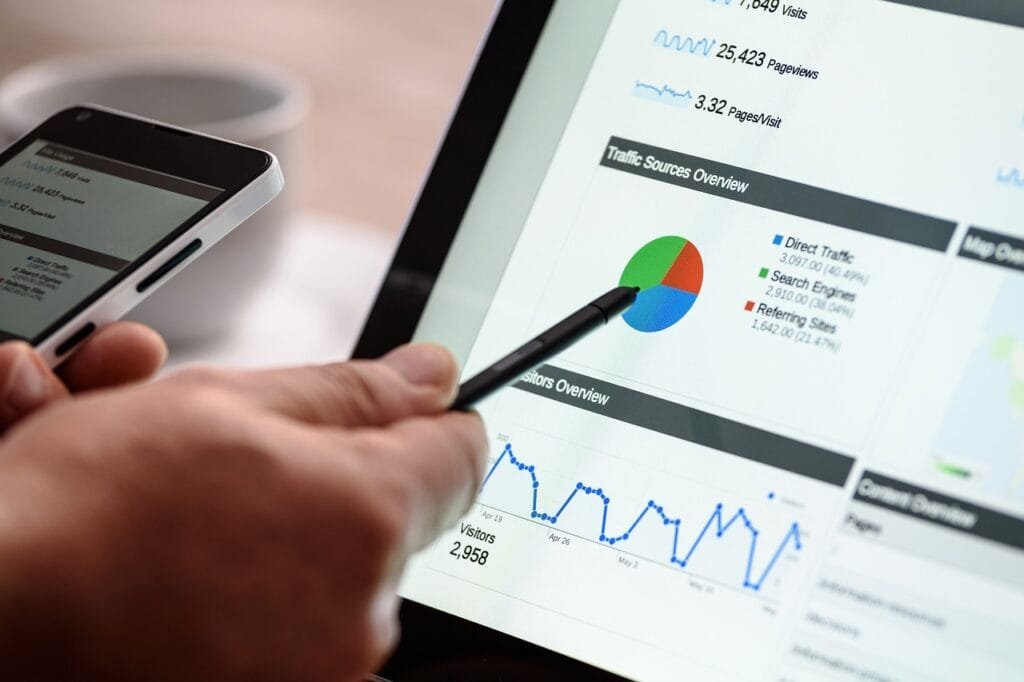This Article has been revised, edited and added to, by Poulomi Chakraborty.
- The Comparison Between Social Media Marketing and Traditional Marketing
- Harnessing the Power of Influencer Marketing
- Optimizing Social Media Ad Campaigns
- Mastering Content Creation for Social Media Engagement
- Building and Maintaining an Online Presence
- Essential Tools for Enhancing Your Social Media Marketing Strategy
- Advanced Strategies for Leveraging Social Media Tools Effectively
- Integrating Social Media Strategies into a Cohesive Digital Marketing Plan
- Optimizing and Measuring the Effectiveness of Digital Marketing Campaigns
- Conclusion
Social media is more than just a platform to catch up with friends and share selfies; it has morphed into a powerhouse tool for digital marketers everywhere. It shapes how we introduce, discuss, and promote products and services in an increasingly connected world. In this article, we’re going to explore the intricacies of social media’s influence in digital marketing and unearth some strategies to make the most out of this dynamic tool.
The Comparison Between Social Media Marketing and Traditional Marketing

When delving into the role of social media in digital marketing, it’s vital to start with a comparison to its more traditional counterpart. Traditional marketing, encompassing television ads, print media, and billboards, has ruled the advertising world for decades. However, the advent of social media has introduced a significant shift in how brands interact with consumers.
Reach and Engagement
The most striking difference between social media marketing and traditional marketing is the scope of reach and the level of engagement. Traditional marketing methods are often like casting a wide net with the hope of catching a few interested customers. For example, a television ad might reach thousands—even millions—but the level of interaction it garners is minimal. Viewers can’t immediately click a link or engage in an interactive dialogue with the brand.
Social media, on the other hand, offers a much more targeted approach. Platforms like Facebook, Instagram, and Twitter allow marketers to use sophisticated algorithms to deliver content directly to individuals who are most likely to be interested in their products or services. This targeting capability is not just based on demographics but also on user behavior, preferences, and social interactions.
Moreover, the engagement on social media platforms is unprecedented. Users can like, comment, share, or even directly message brands. This two-way interaction fosters a deeper relationship between the consumer and the brand. Each interaction on a social media post also increases its visibility, further enhancing its reach organically without additional cost.
Speed and Flexibility
Another critical comparison point is the speed and flexibility offered by social media compared to traditional channels. Traditional marketing campaigns, such as those on TV or print, require extensive planning and production time. They are also relatively inflexible, as once an ad is aired or a billboard is posted, making changes can be cumbersome and expensive.
Social media marketing excels in its agility. Campaigns can be launched rapidly and tweaked almost instantly based on real-time feedback from the audience. If a particular type of content isn’t resonating, marketers can quickly shift their strategy without significant downtime or financial loss. This ability to adapt swiftly is crucial in a digital landscape where consumer interests and online trends can change overnight.
Cost-Effectiveness
Cost is a major factor in any marketing strategy, and here too, social media has an edge. Traditional marketing channels often involve high costs for production and distribution. A single ad spot during a popular television event can cost millions, making it inaccessible for smaller businesses.
Social media platforms, in contrast, offer a more economical model. Creating and posting content can be relatively low-cost, even free if you exclude paid promotions. Additionally, the return on investment on social media can be precisely tracked and often exceeds that of traditional marketing due to the targeted nature of social ads and the organic reach they can achieve through shares and likes.
As we continue to explore the expansive role of social media in digital marketing, we’ll dive deeper into how brands can leverage these platforms to build stronger connections, enhance brand loyalty, and drive sales in ways that were not possible with traditional marketing tactics.
Harnessing the Power of Influencer Marketing

One of the most powerful strategies in social media marketing is leveraging influencers. Influencers are individuals who have a significant following on social media platforms and can sway the opinions and purchasing decisions of their audience. The beauty of influencer marketing lies in the authenticity and trust that these influencers have cultivated with their followers.
Choosing the Right Influencers
The key to a successful influencer marketing campaign is choosing the right influencers. This doesn’t always mean going for those with the highest number of followers. Relevance, engagement rate, audience demographics, and the authenticity of the influencer are crucial factors to consider. For instance, a local boutique would benefit more from partnering with an influencer who has a strong following in their city rather than a global celebrity whose followers are spread worldwide.
Crafting Collaborative Content
Once the right influencers are on board, the next step is to collaborate on content creation. This should be a balanced endeavor where the influencer’s creative freedom and the brand’s marketing objectives align. An effective way to do this is through co-creating content that feels natural and not overly promotional. For example, instead of just having an influencer post a picture with a product, they could share a personal story or an experience that features the product, thereby giving the promotion a more organic feel.
Measuring Impact
To gauge the success of an influencer marketing campaign, it’s crucial to look beyond likes and shares. Metrics such as engagement rate, traffic to the website from the influencer’s content, and conversion rates provide deeper insights into the campaign’s effectiveness. Using specialized tools or platforms that track these metrics can help brands optimize their strategies in real-time.
Optimizing Social Media Ad Campaigns
Another vital aspect of social media’s role in digital marketing is the strategic use of paid advertisements. Social media platforms offer advanced targeting options that allow marketers to reach specific audiences based on detailed criteria.
Targeting the Right Audience
Effective ad campaigns begin with precise targeting. Platforms like Facebook and Instagram offer options to target users based on location, demographics, interests, behaviors, and even their recent purchase history. For instance, a sports apparel brand could target users who have shown interest in fitness pages or have recently purchased gym equipment online.
Creating Engaging Ad Content
The content of the ads needs to grab attention within seconds. Using high-quality visuals, engaging videos, and compelling copy are essential. A/B testing different versions of ads can help determine what works best in terms of layout, imagery, call to action, and messaging.
Continuous Optimization
The work doesn’t stop once the ads are running. Continuously monitoring the performance and optimizing based on data is key. This might mean adjusting the budget, tweaking the ad copy, or even changing the target audience based on who is responding best to the campaign.
Social media advertising is powerful not just for direct sales, but also for building brand awareness and loyalty, which are invaluable in the long term.
Social media’s role in digital marketing is multifaceted and continuously evolving. It offers an array of tactics for businesses to not only reach their audience but to engage with them on a level that traditional marketing cannot match.
Mastering Content Creation for Social Media Engagement

Creating content that resonates with your audience is the cornerstone of a successful social media strategy. It’s not just about posting regularly, but posting content that is engaging, relevant, and valuable to your followers.
Understanding Your Audience
Before you create content, you need to understand who your audience is and what they care about. This involves analyzing data on who follows you, who interacts with your posts, and what kind of content generates the most engagement. Tools like Google Analytics, Facebook Insights, and Instagram Analytics can provide a wealth of information about your audience’s demographics, interests, and behavior.
Diversifying Content Types
To keep your social media feeds interesting, it’s important to vary the types of content you post. This can include:
- Images and Videos: These are highly engaging and can convey more information than text alone. Videos, in particular, are effective in capturing attention and can lead to higher engagement rates.
- Stories and Live Streams: Using Instagram Stories or Facebook Live sessions can help in connecting with your audience in real-time, making your brand feel more relatable and accessible.
- Educational and How-To Content: These help in providing value to your audience, positioning your brand as an authority in your field.
- User-Generated Content: Sharing content created by your followers can increase engagement and loyalty, as it shows that you value their input and interaction.
Consistency and Brand Voice
While variety is important, consistency in your posting schedule and brand voice helps build trust and recognition. Your brand’s voice should reflect its personality and values, and this should be consistent across all posts and interactions. Scheduling tools like Buffer or Hootsuite can help maintain a regular posting schedule.
Building and Maintaining an Online Presence
An active online presence extends beyond just posting on social media. It involves monitoring interactions, responding to comments, and staying updated with the latest digital trends.
Engagement Is Key
Always respond to comments, messages, and reviews promptly. This not only improves your relationship with your audience but also boosts your visibility due to the platform’s algorithms favoring active interactions.
Monitoring Brand Mentions
Use tools like Mention or Google Alerts to keep track of when your brand is mentioned online. This can help you manage your reputation and respond to any negative mentions or feedback swiftly.
Staying Current with Trends
Social media trends can change rapidly. Brands that stay on top of these trends and adapt accordingly can maintain a strong online presence. This includes adapting to new platforms, technologies, and the changing preferences of your audience.
Continuous Learning and Adaptation
The digital landscape is constantly evolving, so continuous learning and adaptation are necessary. Participate in webinars, follow industry leaders, and keep up with relevant news to stay informed and ahead in your strategies.
Social media is a dynamic and powerful tool for digital marketing, offering numerous ways to connect with customers, build brand loyalty, and drive sales. By understanding and leveraging the unique features of each platform and engaging actively with your audience, you can significantly enhance your brand’s online presence and effectiveness.
Essential Tools for Enhancing Your Social Media Marketing Strategy

In the world of digital marketing, having the right tools can make a significant difference in how effectively you manage and execute your social media strategies. These tools not only save time but also provide valuable insights that can help optimize your efforts and boost your results.
Social Media Management Tools
Hootsuite and Buffer
Both Hootsuite and Buffer are excellent for scheduling posts across multiple social media platforms. They allow you to plan your content calendar, post at optimal times without manual intervention, and analyze the performance of your posts. These tools can help you maintain a consistent presence on social media, which is key to engaging and growing your audience.
Sprout Social
Sprout Social provides a more comprehensive suite that includes scheduling, analytics, and engagement tools. It also offers features for listening and monitoring, which can be invaluable for understanding audience sentiment and discovering new trends in real time. Sprout Social’s detailed reporting tools help you measure and refine the impact of your social media campaigns.
Analytics Tools
Google Analytics
For tracking the effectiveness of your social media efforts, Google Analytics is essential. It not only shows how much traffic your social media channels are driving to your website but also provides insights into the behavior of visitors once they arrive. By setting up goals and tracking conversions, you can see exactly how your social media efforts are contributing to your business objectives.
BuzzSumo
BuzzSumo is a powerful tool for content research and performance analysis. It allows you to see which types of content are most popular and engaging across social media platforms. This can help you understand what topics and formats are likely to resonate with your audience, informing your content creation strategy.
Engagement and Customer Service Tools
Zendesk and HubSpot
For brands with a significant volume of customer interactions on social media, tools like Zendesk and HubSpot are essential. They integrate customer service processes with social media platforms, allowing you to manage and respond to customer inquiries and issues directly through these tools. This integration helps maintain a responsive and efficient customer service experience.
Mention
Mention lets you monitor your brand across the internet—including social media, blogs, and websites. You can track every mention of your brand to manage your reputation effectively, engage with users who talk about your brand, and capitalize on positive sentiment.
Content Creation and Optimization Tools
Canva and Adobe Spark
For creating visually appealing graphics and videos, Canva and Adobe Spark are user-friendly options. They come with templates and easy-to-use interfaces that make it simple to design professional-looking graphics that are optimized for various social media platforms.
InVideo
InVideo is a tool specifically for creating and editing videos, which are crucial for engagement on social media. With a range of templates and a user-friendly interface, InVideo helps you produce high-quality videos that can capture attention and engage viewers.
By leveraging these tools, marketers can streamline their social media operations, from content creation and scheduling to engagement and analytics. This allows for more efficient management of campaigns and a better understanding of what drives success.

Related: Check out our free SEO suite

Advanced Strategies for Leveraging Social Media Tools Effectively
Once you’re equipped with the right tools, the next step is to maximize their potential through strategic use. Here, we’ll explore advanced strategies for leveraging your social media tools to enhance your digital marketing efforts significantly.
Strategic Scheduling and Automation
Optimal Timing
Using tools like Hootsuite and Buffer, you can not only schedule posts but also strategically plan your posting schedule based on when your audience is most active. These platforms provide analytics that show peak engagement times throughout the day or week. By scheduling posts during these peak times, you can maximize visibility and engagement.
Automation with Personalization
While automation saves time, it’s important to maintain a personal touch. Customize automated posts for each platform to cater to its unique audience and style. For example, what works on Twitter, with its character limit and fast-paced feed, won’t necessarily work on Facebook. Tailoring content specifically for each platform can enhance engagement and make automated posts feel more personal.
Comprehensive Analytics to Drive Decisions
Segmenting Data
Tools like Google Analytics and Sprout Social offer capabilities to segment your data. This means you can analyze the behaviors and preferences of different demographics within your audience. By understanding these segments, you can tailor your content and campaigns more effectively to meet the needs and interests of each group.
Conversion Tracking
Set up conversion tracking in Google Analytics to see how well your social media efforts are translating into actionable outcomes like sales, sign-ups, or other business goals. By understanding what drives conversions, you can better allocate your budget and focus towards the most effective strategies and platforms.
Enhanced Engagement Through Social Listening
Real-Time Monitoring
Using Mention or Sprout Social’s listening features, you can monitor conversations about your brand in real-time. This allows you to respond quickly to positive feedback or address negative comments before they escalate. Real-time engagement shows your audience that you’re attentive and committed to customer satisfaction.
Trend Analysis
Social listening tools also allow you to identify trends as they emerge. By jumping on relevant trends quickly, you can make your brand appear more relevant and connected with current events or popular culture. However, ensure the trends align with your brand values and audience interests to maintain authenticity.
Content Optimization with A/B Testing
Visual Content Testing
Use Canva or Adobe Spark to create multiple versions of visual content, then test these variations to see which performs better. You might change the image, the layout of the text, or even the color scheme. Tools like Facebook’s A/B testing feature allow you to run these tests directly on your audience to get clear data on what’s more effective.
Video Content Enhancements
With tools like InVideo, experiment with different video lengths, formats, or introductions. Testing different types of video content can help you understand what keeps your audience engaged, helping you refine your video marketing strategy.
By implementing these advanced strategies, you can use your social media tools not just to maintain your presence but to actively improve your digital marketing outcomes. Through strategic scheduling, detailed analytics, proactive engagement, and continuous content optimization, your brand can not only reach but resonate with your audience more effectively.
Integrating Social Media Strategies into a Cohesive Digital Marketing Plan

A cohesive digital marketing plan ensures that all online activities not only align with each other but also with the overall business objectives. Integrating advanced social media strategies effectively into this plan involves a systematic approach where each element supports and amplifies the others. Here’s how you can blend these social media strategies into a broader digital marketing framework.
Setting Clear Objectives
Start by defining clear, measurable objectives for your digital marketing efforts. These could be increasing brand awareness, boosting sales, enhancing customer engagement, or driving traffic to your website. Each objective should have corresponding KPIs (Key Performance Indicators) to measure success. For instance, if the goal is to increase brand awareness, relevant KPIs might include metrics like reach, engagement rate, and follower growth on social media platforms.
Audience Segmentation and Targeting
Use the insights gained from tools like Google Analytics and social media analytics to segment your audience into distinct groups based on demographics, interests, behaviors, and engagement patterns. This segmentation allows for more targeted and personalized marketing campaigns. For each segment, tailor your social media posts, ads, and content to match the preferences and behaviors of that specific group.
Content Strategy
Develop a content strategy that integrates seamlessly across all digital channels. This strategy should leverage the strengths of each platform while ensuring a consistent brand message. Use:
- Visual content on Instagram and Pinterest.
- Short, engaging updates on Twitter.
- In-depth articles and videos on Facebook and YouTube.
- Professional content on LinkedIn.
Ensure that all content is optimized for each platform but carries a cohesive theme and messaging that aligns with your broader marketing goals.
Tactical Execution with Tools
Implement the strategic use of tools for scheduling, analytics, and engagement across platforms:
- Scheduling tools like Buffer and Hootsuite can help maintain a consistent posting schedule.
- Analytics tools provide insights into what’s working and what’s not, allowing for real-time adjustments to campaigns.
- Engagement tools ensure that you respond promptly to customer interactions, keeping the audience engaged and loyal.
Cross-Promotion and Integration
Ensure that your social media efforts are integrated with other elements of your digital marketing strategy:
- Email Marketing: Use social media to increase sign-ups for your newsletters and vice versa.
- SEO: Share content that includes keywords to improve both social media visibility and search engine rankings.
- Website: Drive traffic from social media to your website and ensure your website includes social sharing buttons.
- Ads: Coordinate your social media ads with display ads, retargeting efforts, and other paid marketing tactics to reinforce the message across platforms.
Continuous Improvement
Leverage the data from your social media and digital marketing campaigns to continuously refine and improve your strategies. Regularly review your analytics to understand the impact of specific tactics and make data-driven decisions to enhance your digital marketing efforts.
By treating social media as an integral part of your overall digital marketing strategy, rather than a standalone component, you can create a more unified and effective approach to marketing your brand online. This integration not only helps in maximizing the impact of each campaign but also in building a stronger, more consistent brand presence across all digital touchpoints.
Optimizing and Measuring the Effectiveness of Digital Marketing Campaigns

Effective measurement and optimization are critical for the success of any digital marketing campaign. By understanding how to track, analyze, and adjust your strategies based on performance data, you can ensure that your campaigns not only meet but exceed your marketing goals. Here’s a detailed look at how to effectively measure and optimize your digital marketing efforts.
Key Performance Indicators (KPIs)
To start, it’s essential to identify the right KPIs that align with your business goals. These could include:
- Engagement Rates: Likes, comments, shares, and overall interaction levels.
- Conversion Rates: The percentage of users who take a desired action, such as making a purchase or signing up for a newsletter.
- Traffic: The number of visitors to your website from various channels.
- ROI (Return on Investment): The financial return on your marketing expenditures.
- Customer Lifetime Value: The total revenue you can expect from a single customer throughout their relationship with your business.
Selecting relevant KPIs allows you to focus on metrics that truly matter to your business, helping you to allocate resources more efficiently and effectively.
Tools for Tracking and Analysis
Several tools can help you track these KPIs and provide insights into your campaign’s performance:
- Google Analytics: Tracks website traffic, user behavior, and conversion metrics. It’s invaluable for understanding how users interact with your site after clicking through from social media or other channels.
- Social Media Analytics: Platforms like Facebook Insights, Twitter Analytics, and LinkedIn Analytics offer detailed data about engagement and reach on their respective platforms.
- SEO Tools: Tools like SEMrush and Ahrefs can help monitor your search engine rankings and the health of your SEO efforts, providing insights into how organic search is contributing to your overall goals.
A/B Testing
A/B testing is crucial for optimizing your campaigns. This involves creating two versions of a campaign (A and B) and testing them with segments of your audience to see which performs better. You can test various elements such as:
- Email Marketing Campaigns: Different subject lines, email content, or call to actions.
- Landing Pages: Variations in design, content placement, or buttons.
- Social Media Ads: Different images, headlines, or audience segments.
Use the results from A/B testing to refine your strategies, focusing on the approaches that deliver the best outcomes.
Continuous Optimization Cycle
The optimization of digital marketing campaigns should be a continuous process:
- Plan: Define what you want to achieve.
- Execute: Deploy your strategies across chosen digital marketing channels.
- Measure: Use tools to track performance against your KPIs.
- Analyze: Look at the data to identify what’s working and what isn’t.
- Adjust: Make changes based on your analysis to improve campaign performance.
By regularly going through this cycle, you can ensure that your marketing efforts remain fresh and relevant, and continue to drive significant results.
Integrating Insights Across Channels
To maximize effectiveness, integrate insights across all marketing channels. If data shows that certain content types are performing well on social media, consider incorporating similar content into your email campaigns or your website. Conversely, if email or direct traffic is driving a high number of conversions, look at how social media can support these channels through targeted ads or promotional content.
By taking a holistic view of your digital marketing efforts and continuously measuring and optimizing performance, you can create a robust strategy that not only meets the immediate goals but also scales effectively with your business growth.
Conclusion
In conclusion, social media’s role in digital marketing is transformative, bridging the gap between brands and consumers with unprecedented efficiency and intimacy. By leveraging the power of strategic scheduling, targeted advertising, and influencer collaborations, businesses can not only boost their visibility but also enhance engagement and foster deeper customer loyalty. Tools like Google Analytics, Hootsuite, and Canva are invaluable in crafting, managing, and refining these strategies, providing businesses with the insights needed to make data-driven decisions.
Through continuous monitoring, A/B testing, and adapting to emerging trends and feedback, marketers can optimize their campaigns for better performance and ROI. Ultimately, integrating these social media tactics into a cohesive digital marketing plan ensures a harmonious and effective online presence, aligning closely with broader business objectives and driving sustainable growth. The journey through digital marketing is continuous and ever-evolving, demanding creativity, adaptability, and a keen understanding of technological advancements to stay ahead in the competitive digital landscape.
Read Next:
- Importance of Local Citations for Green Businesses
- Optimizing Google My Business for Sustainable Brands
- Local SEO Tactics for Green Brick-and-Mortar Businesses
- User-Generated Content: Harnessing Reviews and Testimonials for Alternative Energy Startups
- Blog Post Ideas to Promote Sustainability and Amplify Your Sustainability Startup






















Comments are closed.